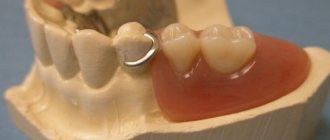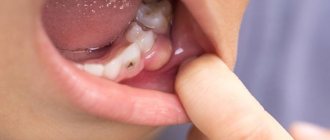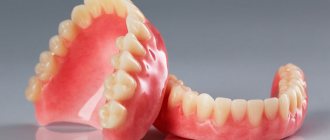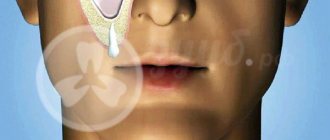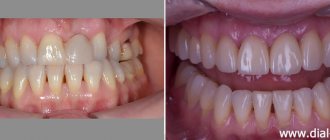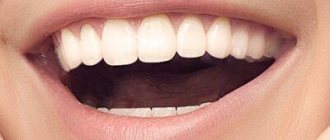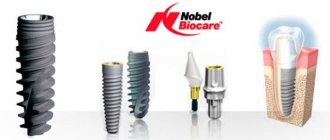The absence of 2 teeth in a row is a common defect that often occurs in patients. The problem needs to be eliminated, because the bone will atrophy, and over time it will be more difficult to solve it. Implantation is considered the best way to restore several teeth in a row, since it is the installation of durable artificial roots that will last a lifetime. On top they are covered with crowns, which completely preserve the function of chewing and recreate the aesthetics of a smile. The choice of implantation method depends on how long ago the teeth were removed and the structural features of the patient’s jaw.
Is it possible to implant 2 teeth at once?
Implanting 2 teeth is no different from restoring one tooth. Artificial roots are also placed, which are then covered with crowns. It is better to install both units at once, without dividing them by time. This will reduce the preparation time, there will be no repeated anesthesia and double antibiotic therapy, which is undesirable to carry out more than once every six months.
Implantation is usually performed using the classical method:
- Installation of an artificial root and prosthetics are separated by 2-6 months, which are needed for the implants to heal.
- First, an implant is placed, the gum is sutured, and fusion occurs with the bone tissue.
- After 2-6 months, the gum is cut, an abutment is placed, and the implant is covered with a crown.
During osseointegration, a removable temporary butterfly immediate prosthesis is worn.
Implantation of two teeth side by side
Depending on the location of two missing teeth in a row, the requirements for implants and crowns differ.
Front teeth
When installing implants in the frontal area, there are features:
- increased demands are placed on aesthetics;
- Individual zirconium abutments are used;
- if necessary, gum plastic surgery is performed;
- narrow implants are installed for a narrow frontal area;
- before the implants heal, temporary or lightweight crowns or butterfly prostheses are placed, which are attached to adjacent teeth;
- After engraftment, metal-free zirconium dioxide crowns are installed with the color most closely matched to the shade of adjacent teeth.
Chewing teeth
If there are no two teeth in a row in the lateral zone, thin short implants are not suitable for restoring such units. Wider ones are used so that they can cope with chewing loads. We use durable crowns; we install metal-free ones made of zirconium. Such prostheses last for 20 years and are fully compatible with the body. Immediate loading of the implant with crowns is not permissible, since artificial roots that have not taken root may move during chewing.
Treatment and implantation of two teeth
Attending doctor
Strigin Vladimir Igorevich
Find out the price
Features and options depending on the location of the defect
Upper jaw
The jaw bone on top has a loose structure - more implants are required, and they take 1-2 months longer to take root than in the lower jaw. The bone tissue on top is smaller in height; after the loss of an element, it quickly atrophies. In addition, the maxillary sinuses are located close to the upper jaw, so implantation should be carried out with extreme caution.
When choosing a classic protocol for bone deficiency, bone grafting (sinus lift) and installation of 2-3 classical implants are required. As part of a one-stage protocol, 3-4 one-piece implants are implanted, eliminating bone grafting and shortening the treatment period.
Lower jaw
The bone tissue of the lower jaw has a less loose structure; implants take root here faster. The bone is not as susceptible to atrophy as the upper one, but with a long absence of teeth, the likelihood of active tissue destruction is high. In addition, surgery on the lower jaw is complicated by the proximity of the mandibular nerve, which is taken into account after a CT scan.
Installing three implants using a one-stage protocol is the best option for the lower jaw. Instant installation of an orthopedic structure allows you to speed up the healing of implants and reduce the number of dietary restrictions.
Front teeth
If three or more teeth are lost in the frontal area, 3 classic implants are installed, after which they are healed, single crowns are placed. The method helps to achieve a highly aesthetic result (artificial units look natural, an even gum contour is formed). In case of bone deficiency, bone grafting is performed.
It is not always possible to implant 3 monoblock implants within the framework of a one-stage protocol on the front teeth: an extended defect is needed to fix the products, and the frontal units are usually small in size. The fact is that titanium roots are installed at an angle (to avoid bone tissue buildup) - the roots of neighboring elements can be touched.
Chewing teeth
It is preferable to install monoblock implants (3-4 pieces) in place of 3 missing chewing teeth. Titanium roots are implanted at an angle into areas of “quality” bone, bypassing the roots of neighboring units. The implants are immediately loaded with a prosthesis consisting of 3 crowns.
You can install 3 classic implants, but the teeth in the chewing area are most subject to stress, and the likelihood of bone atrophy is high. When choosing a classical technique, bone tissue will need to be augmented before implantation.
Is it possible to place one implant on two teeth?
This is impossible, since when installing one implant with two crowns, one of them will be suspended. This will create a natural lever that will eventually dislodge the artificial root from the bone. If the dental units are small and located close to each other, there is the option of installing two mini-implants. This way the load will be distributed evenly, but this option is temporary.
Theoretically, there are possible options that we do not practice:
- If there is no central and lateral incisor in the upper jaw, then you can place one implant in the center and hang a small lateral tooth on it. This will reduce the load.
- If there are no two incisors on the lower jaw, then you can make one implant and place 2 crowns with minimal load.
- You can install one implant and place a bridge supported by it and a living tooth. But this is strictly not recommended. Living teeth are mobile, and artificial roots are firmly attached to the bone - a shock-absorbing effect will occur, which will lead to loosening of the prosthesis, dislocation of one or both supports.
Prosthetics of molars at the ILATAN clinic
Modern dentistry offers many durable solutions that provide maximum patient comfort while at the same time providing excellent aesthetic, functional and therapeutic results. When choosing a prosthetic restoration, we take into account the patient's existing conditions and expectations. By scheduling a free consultation with an orthopedist or implantologist at any of the ILATAN family dentistries by phone, you will find out which dental restoration option is right for you and can take advantage of high-quality dental services at affordable prices.
Implantation for isolated absence of 2 teeth
1 implant is placed in each defect area. The choice of shape and size of the artificial root depends on the location on the jaw - in the anterior or frontal area.
Simultaneous installation of two separate roots is feasible if the patient still has the normal ability to eat:
- defects are located on one side of the jaw;
- on different jaws, but on the same side.
Otherwise, the operation is divided over time. For example, if two teeth are missing at the same time - one is upper left, the second is lower right.
Primary and secondary edentulous teeth
Experts distinguish several types and subtypes of adentia. For greater convenience, below are tables showing the types of the disease, combined by certain characteristics.
Primary adentia
Caused by hereditary factors and diseases at the stage of fetal formation. With primary adentia, there is an absence of tooth germs.
Varies:
- partial primary adentia - the absence of one or more rudiments (for example, primary adentia of two incisors);
- complete primary adentia – absence of all tooth buds. It is extremely rare;
- true adentia – absence of tooth buds (without their destruction by diseases and infections);
- false edentia, when different teeth merge into one.
Secondary adentia
Secondary adentia (ICB K 08.1) occurs as a result of illnesses and injuries during life.
Is it possible to install implants immediately after removing 2 teeth?
This method is possible. Single-stage implantation is used, in which the implant is placed immediately into the hole after tooth extraction. But the following conditions must be met:
- the procedure is planned in advance to allow for diagnostics and assessment of the operation;
- removal was carried out atraumatically, without damaging the alveolar process;
- there should be no inflammation, cysts, granulomas, purulent processes;
- the volume of bone tissue is sufficient for the implant to be securely fixed.
Pain after prosthetics
After installation of the orthopedic structure, the patient may experience pain. They are mainly caused by either adaptation of oral tissues to the elements of the prosthesis, or the development of inflammatory processes. Pain due to adaptation goes away on its own or after correction of the structure.
But pain after dental prosthetics, caused by inflammation, is fraught with dangerous consequences, so if they last longer than a few days, do not subside, but intensify, are accompanied by an unpleasant odor, the discharge of pus, it is urgent, without delay, to consult a doctor.
The cause of pain may be untreated foci of infection in the oral cavity, infection as a result of errors in the installation of the structure or previous preparatory operations, violation of the rules for using the prosthesis and oral hygiene, allergic reactions to the materials used in dental prosthetics, as well as too tight, or, conversely, , insufficiently tight fit of the prosthesis to the soft tissues.
In order to identify the causes of inflammation and cure it, it is necessary to contact a dental clinic, otherwise this can lead to breakage of the prosthesis, rejection of its structural elements and serious complications.
Doctor's advice - crowns can be placed immediately
For this purpose, a one-stage implantation method is used, when an implant is placed and covered with a crown on top, without waiting for its engraftment. The method is used when there is a sufficient amount of bone tissue. Used for dental units that do not actively participate in chewing. The crown is placed temporary, made of plastic or metal-plastic, and removed from the bite (lower in height) to eliminate active loads. After engraftment, it changes to permanent.
Levin Dmitry Valerievich
Chief physician, Ph.D.
Which is the best method to choose?
There is an alternative to dental prosthetics using implants, and for those who, due to contraindications or other reasons, cannot undergo implantation, this is a real salvation. And in each individual case, a method is selected based on specific conditions, the nature of the clinical picture, the requirements and capabilities of the patient.
But still, when choosing, it is necessary to take into account that implantation today is essentially the only method that provides complete restoration of the functionality of the dental system, including stopping bone atrophy. Perhaps a full-fledged alternative to dental implantation will appear in the near future, but for now it does not exist - all methods of prosthetics without implantation have disadvantages and do not ensure the transfer of chewing load to the bone, which causes degradation of the jawbone, gradual displacement and destruction of the remaining teeth.
When is bone augmentation needed?
For implantation to be carried out flawlessly, a sufficient amount of bone tissue is required. If teeth are missing for more than a year, then in 95% of cases bone grafting will be needed due to atrophy. Osteoplasty is needed so that the implant does not damage blood vessels, nerves, and recreates normal anatomy. The strength of root fixation also depends on it.
Our Center uses the following methods:
- Sinus lifting is a bone grafting procedure performed on the upper jaw in the area of the maxillary sinus. The mucous membrane is lifted, the vacated space is filled with bone chips. Often performed simultaneously with implantation.
- Guided bone regeneration - the gum is exfoliated, bone material is added, and covered with a membrane. Implants are installed at the same time if the bone deficiency is small. Recovery takes six months.
Implantation without bone grafting is possible when, along with implantation, the process of tissue growth begins. This technology is optimal; bone growth stimulators are fixed to the neck of the implant. The procedure is low-traumatic, but expensive. Its type - autotransplantation (transplantation of bone blocks from other parts of the human body) - is not used in the clinic, because the blocks can dissolve.
The sooner the tooth is restored, the less bone loss develops, so surgery to build it up may not be necessary.
Consequences of edentia
A disease such as adentia has a huge number of negative consequences. A person is not able to clearly pronounce individual sounds, speech becomes slurred and unpleasant for others, it is very difficult for such people to find work in the field of social communications where constant communication is required. Some types of food, such as tough and hard foods, simply become inaccessible, since in order to bite off and thoroughly chew meat, you need a full set of teeth. Such a person is doomed to lifelong intake of liquid food. And if at first glance this problem does not seem so terrible, then it is worth considering it from a slightly different angle. Due to the lack of vitamins that the body must receive from solid food, after some time the patient begins to develop diseases of the stomach and intestinal tract, as well as the body as a whole. In this connection, the problem of edentia cannot be postponed until later.
The doors of YuliSTOM dental clinics in St. Petersburg are open 7 days a week!
You can both get advice and get rid of edentia in our dental clinics. Moscow metro station Zvezdnaya, Danube Avenue, 23
Price
The clinic uses a case payment system. The cases are designed for installation of 1 implant. Accordingly, if two teeth are missing, the package cost will double.
The cost of the surgical stage includes:
- anesthesia;
- implant;
- plug, abutment, former;
- complex of reconstruction and basic bone augmentation;
- repeat CT.
The price of implants varies depending on the type of bone. Nobel Biocare PMC (cheaper) is intended for weak bones, and Nobel Biocare Conical Parallel CC (more expensive) is for dense bone tissue.
The cost of prosthetics includes:
- making a crown;
- taking impressions;
- installation.
Paid separately:
- tooth extraction with one-stage implantation - the price depends on the complexity (simple is cheaper, complex is more expensive);
- bone grafting or sinus lifting if necessary - the price depends on the amount of bone material and the method of osteoplasty.
Guarantees
Our Center uses implants with a lifetime guarantee - Nobel Biocare. We provide guarantees:
- 2 years for treatment;
- 1 year for prosthetics;
- lifetime for implantology.
Warranty obligations apply provided that the patient follows the doctor’s recommendations, rules of care and regularly visits the dentist. The warranty program includes a complex: for an implant, surgery, bone reconstruction and prosthetics.
Alternatives to implantation
- Dental bridge - structures in the form of welded crowns are placed in place of missing teeth. Along the edges they rest on supporting living teeth, the middle pendant teeth replace lost teeth. The method has disadvantages - grinding and depulping of supporting units, the process of bone atrophy continues, short service life in comparison with implants - up to 15 years.
- A removable denture is an artificial gum with plastic crowns. It is attached to adjacent teeth with hooks or to the gums using suction. Under such prostheses, bone atrophy progresses with greater force. In addition, it is uncomfortable for a person to chew, and long-term addiction occurs. Service life - up to 7 years.
Causes of loss of chewing teeth
In childhood, the main reason for the loss of chewing teeth is the absence or death of their rudiments. There may also be hereditary or external factors that have a direct impact on the fetus even at the stage of formation of its entire skeletal system. Parents should very carefully monitor the health of their children’s baby teeth, because if timely treatment is not carried out, the consequences can be very dire – including the premature loss of permanent ones.
In adult patients, the main cause of early tooth loss is various dental problems: pulpitis or periodontitis, as well as diseases of periodontal tissues, which begin with inflammation of the gums - periodontitis, less often - periodontal disease. In addition, these diseases can develop against the background of hormonal or age-related changes, diabetes mellitus, and metabolic disorders in the body. Loss of chewing teeth can also occur due to trauma to the jaw system or after prolonged wear, for example, of bridges.

